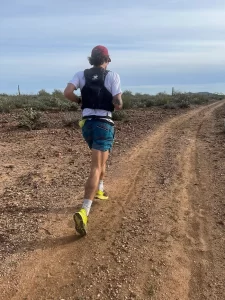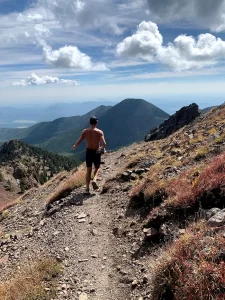One of my favorite ways to improve runners’ overall fitness and climbing capabilities is with longer, high-effort, uphill trail intervals.
Let’s go over what they look like and how to utilize them.
I generally use these types of workouts with my ultra and trail athletes, but road runners and marathoners have also been known to use workouts like this.
If we have a trail race coming up, we want to find a trail that’s of similar technicality and terrain. The grade of the trail is tough to pinpoint. We want a challenging climb, but we also want it to be runnable. The grade could be anywhere from 4-9%, depending on your climbing abilities and what race you’re training for.
“If you can’t push yourself up the Hill, then the grade is too high!”
The workouts themselves are fairly simple. I have an excellent example of my friend and superstar professional ultra runner, Jared Hazen, running a 4x4minute uphill trail workout.
After we warm up and get to the bottom of the hill we’re going to use, we will run the hard portions of the workout uphill, on the trail, and really easily jog back down the trail. If the workout is set up to an equal rest-to-work ratio (the same amount of time running hard vs. recovery, like 4 minutes hard and 4 minutes rest), like in this example, you will usually not get all the way back down to where you started. This means when selecting the hill for the workout, you will need a long, steady climb. If you can’t find a hill that long, then on some of the rests, you’ll have to take a longer rest interval to get all the way back down. It’s not ideal, but it’s totally fine and workable.
So we will generally run HARD up the hill and jog back down easily. It takes some time and experience to learn how to run hard for that long uphill on a trail. It’s easy to take off too fast and run out of steam before the end of the interval. Sometimes, we won’t be moving very fast, but all we’re looking for is the correct effort, about an 8 out of 10. For some of us, this might mean we’re barely jogging; if it’s up a hill, we would have usually power-hiked.
Why These Workouts are so Effective!
Why do we love and use these workouts? Well, it’s a really efficient way to get a lot of vertical running in. Running hills has so many benefits. If we’re running a race that has a lot of elevation gain, we need to practice and strengthen our bodies to be able to handle the demands of that event. There’s a lot of positive correlation between the amount of climbing we’re able to do in the training leading up to the event and how well we can perform on race day. In steep races, we spend a lot of time on the climbs themselves. Our bodies are in these positions we’re not as familiar with. Our hip flexor angle is really tight; our calves and Achilles complex are getting stretched much more than normal, flat running. We have to create more knee and foot lift to move our legs up and not just forward. Workouts like these long uphill intervals not only improve our climbing speed but can help us prepare our bodies to be stronger and more injury-resilient.
Adapting to Climbing and Descending

If we aren’t used to running a lot of incline and decline, the first few initial hilly runs can wreck our bodies. Fortunately, we can adapt to this somewhat quickly. Even after only a combination of 4-6 hillier long runs and long uphill interval workouts, most athletes start to notice a big difference in how well their body handles the soreness from the descents, and they often feel more capable in their ability to handle steep climbs.
Letting Go of Pace
Another benefit to just about any hill workout is that the pace of the workout isn’t that important. It’s nearly impossible, in the moment, to calculate the grade adjusted pace for the hill you’re using. Sometimes, we can configure this after the workout. Hill Intervals allow you to let go of paces and focus on just working hard, getting back to the simplistic act of figuring out how to move your body up a steep traverse. We’re watching our footing, we’re breathing incredibly hard, and we’re fighting the mental battle to keep pushing! It’s similar to the mental gymnastics we play during a race. Things are starting to get tough, and we have to figure out how long we can keep up this effort level. We’re trying to put the pain in its place and grind up to the top! When done right, all of our focus is on working hard, and we aren’t thinking about splits at all!
Why Uphill and Not Flat

Doing these intervals uphill, instead of flat or downhill, allows us to get to much higher threshold zones. So aerobically, we’re able to work harder and create a bigger stimulus for our lungs to adapt to. Since the hard parts are done uphill, the gravity and landing impact force our legs experience is somewhat reduced. We’re falling upwards on the faster reps, which takes some of the typical quadriceps muscle loading out of the workout. Since we’re fighting more gravity than usual to run vertically, It doesn’t take much to get into higher zones on uphills, so it’s easier to get to a higher exertion level cardiovascularly without as much strain on the musculoskeletal system. We can make our lungs and heart work harder without having to run at top-end speeds like we would on flat ground. So ideally, our legs aren’t fatigued and tired in the typical fashion after VO2 max intervals, but we still got most of the cardiovascular benefits. VO2 Max intervals on a flat surface are an effective way to improve running fitness, but they require the technicality of running higher rend spends for a good chunk of time. The technicality of these intervals can be somewhat difficult, and they’re usually the highest risk level for injury compared to the other types of workouts we do. When we’re training for a trail race, flat V02 Max intervals are also the least specific. When we do these intervals uphill, we’re incorporating that specificity, they’re easier to execute, and slightly less likely to cause an injury.
Running uphill can be extremely taxing. When we get to spend some time pushing really hard on these uphills, when we get into a race or even just a regular trail run, our normal uphill effort will feel even easier and more efficient.
These workouts are great challenges to practice pushing into higher effort levels. The last minute of these reps tends to be really tough. It’s the perfect opportunity to get out of our comfort levels and see if we can do more than we thought we could.
Find a proper trail for these, and get ready to grind! Good Luck.



